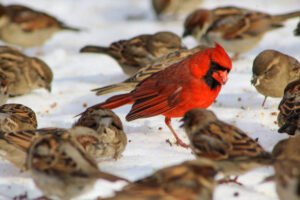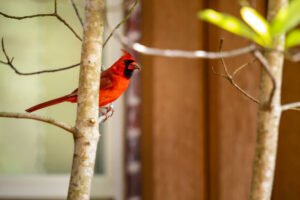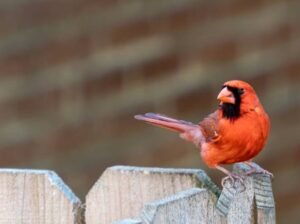Exploring the Preferred Habitat of Northern Cardinals: Where Do They Like to Live?
Where do Northern Cardinal Like to live

Introduction
Salutations and salutations to our pensive explanation of the mysterious world of Northern Cardinals. These magnificent birds, with their bright red feathers and melodic voices, have captured the hearts and minds of avifauna fans all over North America. But have you ever wondered about the exact locations where these fantastic creatures decide to make their home?
Come along with us as we tour their preferred environments and explore the intricacies of their geographic distribution and seasonal migration patterns. Whether you are an avid birdwatcher or just curious about these well-known feathered inhabitants, this piece will pique your interest. Now grab your binoculars and join me as we explore the fascinating world of Northern Cardinal homes.
Habitat Preferences
When considering environmental preferences, the Northern Cardinal tends to be a discriminating home-setter. These colorful birds are often observed in woodland environments, such as meadows and thickets. Their intention is for areas that are rich in lush vegetation that provides plenty of cover and shelter. Cardinals also prefer regions with shady stretches, such as overgrown pastures and the edges of water bodies. These environments combine open areas for feeding with safe havens for breeding.
Interestingly, the female Cardinals are more knowledgeable about identifying their preferred home, which may be related to their essential function in building nests and raising young. These magnificent animals are flexible beings that exhibit specific needs related to their environment. By assimilating their preferences, we may create hospitable environments to entice them and provide comfortable accommodations for these extraordinary, soaring inhabitants.
Geographic Distribution and Range
Known by its common name, the Cardinal, the Northern Cardinal is one of the most popular bird species in North America. It covers a wide range of diverse ecosystems, extending from the southern regions of Canada to the northernmost tip of Mexico. From the dense vegetation to the adjacent suburbs and even metropolitan parks, these colorful structures have successfully adapted to a wide range of environments. The eastern half of the country is where Cardinals are most noticeable in the United States. They continue to exist throughout the year in Virginia, Kentucky, and Arkansas. Still, their range does reach as far west as Arizona and New Mexico.

These adaptable birds thrive in both rural and urban environments. They prefer areas that are abundant in bushes or other trees that are used as nest sites. This includes woodland areas, professionally designed gardens filled with native plants, and hedgerows bordering fields or busy streets anywhere that can provide sufficient shade.
Their preference for areas covered with a lot of foliage has two functions: it protects them from predators and gives them a sumptuous meal. Although seeds are their primary food source, cardinals also enjoy insects and berries when they are available. The next time you stroll through your neighborhood park or gaze into your backyard haven, keep an eye out because you might spot one of these brilliant carmine minstrels perched on a branch or darting around the area.
Factors Affecting Habitat Selection
When it comes to choosing their habitat, Northern Cardinals are dependent on particular preferences that increase their abundance and lifespan. Various factors influence their decision-making. One essential factor is the availability of food. Because they are primarily granivorous, these birds prefer habitats with abundant vegetation and trees that bear berries or seeds. They have a strong preference for places that are abundant in blackberries, mulberries, and sunflower seeds.
The proximity of corresponding nesting locations is another crucial factor for Northern Cardinals. Usually, they build their nests in lush bushes or thickets, 3 to 15 feet above the ground. Their habitat choice is also influenced by how close water sources are, like ponds or streams. Additionally, these magnificent creatures favor areas protected from wide spaces lacking in firm canopy since they avoid dangers from raptors and feline predators.
Furthermore, Northern Cardinals frequently dislike environments burdened by human activity. They will likely avoid areas close to busy roads or noisy city environments. Many factors work together to determine their chosen habitat: easy access to food, ideal nesting locations, natural cover, and safety from predators are all critical factors that determine where they like to live.
Preferred Habitat Characteristics for Breeding and Nesting
Northern Cardinals have unique affinities for their habitat regarding nesting and reproduction. These vibrant organisms prefer areas with thickets and vegetation, which provide plenty of cover and shade. They are also inclined to choose regions that are close to the boundaries of woodland or sylvan domains, as this allows them to move with ease between open spaces and the madhouse of trees. Regarding nesting sites, female cardinals usually choose lush flora, such as low branches of trees or undergrowth, which provides an impenetrable shield against intruders. Sometimes, they will build their nests in high places if there are options.
Surprisingly, Northern Cardinals have a strong preference for building their nests among evergreen vegetation like hollies or pines. Twigs, leaves, grasses, bark strips, and even paper or synthetic materials, if such fall within their scope, make up the nest’s architectural composition. The selected habitat characteristics offer both security and a readily available food supply.
Regarding food, female cardinals prefer environments abundant in seeds, berries, fruits, insects (especially in the breeding season), blooms (for nectar), and even the sap that some arboreal species secrete. By choosing these unique characteristics in their preferred breeding and nesting sites, which are dense underbrush close to the edge of forests with evergreen vegetation that provides privacy, Northern Cardinals increase the likelihood of successful breeding while ensuring an abundance of resources that are easily accessible for their own and their offspring’s sustenance without having to travel far.
Seasonal Migration Patterns and Habitat Utilization
The Northern Cardinal is well regarded for its flashy red uniform, sweet song, and enduring presence in numerous precincts around North America. However, did you know these magnificent creatures are also outstanding examples of seasonal migration patterns? Despite their essential non-migratory nature, there are known cases of Cardinals making brief moves at particular times of the year. When the breeding season is at its peak in the spring and summer, cardinals typically establish their preferred nesting sites among lush shrubs or thickets. These areas offer plenty of protection from predators and hiding pl
aces for nests. They also provide a bountiful harvest of food, which includes fruits, seeds, berries, and insects. When fall officially arrives and the temperature drops, some Northern Cardinals may begin to migrate south. But it’s important to recognize that only some are involved in this journey. Several Cardinals hibernate in their familiar territories over the winter, depending on enough food supplies.

When winter sets in, Northern Cardinals exhibit a preference for wooded areas that have access to bird feeders and other human-provided food. These resources can help people survive the winter, when there may be fewer possibilities for food available to them locally. While Northern Cardinals spend most of the year alone, how they use their habitat varies according to the seasons and the availability of necessary resources like food and shelter. Knowing these patterns might be helpful to bird enthusiasts who want to create inviting environments for these beloved guests of backyard havens.
Human Impact on Northern Cardinal Habitats
Urbanization: The rapid suburbanization and urban growth have led to the loss of several bird species’ native habitats, most notably the beloved Northern Cardinal. When trees are cut down to build roads and buildings, the Cardinals lose their preferred places to build nests and food supplies.
Habitat Fragmentation: Cardinals’ interconnected habitat is harmed by the fragmentation of woody areas by human activities like agronomy or lumber harvesting. This makes it more difficult for them to find good places to breed and to obtain enough food to survive.
Pollution: Environmental contamination, notably air pollution from automobile exhaust and industrial emissions, can hurt cardinal populations. These creatures are vulnerable to changes in air quality that may affect their overall and respiratory health.
Domestic Cat Predation: Outdoor cats are a significant threat to cardinals (as well as other bird species that visit backyard areas) because they hunt or kill them on instinct without intending to eat them.
Climate Variations: Changing climate preferences affect the availability of food supplies for cardinals during specific seasons, which can upset their eating patterns and endanger their long-term survival.
Use of Pesticides: Using pesticides in residential areas can harm not only the insect population that Cardinals rely on but also directly poison these magnificent birds when they consume them during feeding or when they drink contaminated water.
Lighting Pollution: Artificial light that is too abundant at night confuses migratory birds, such as Northern Cardinals, whose eyes follow the stars and can cause them to get lost or crash into buildings.
Deliberate action must be taken to protect cardinal habitats, which includes designing wildlife-friendly gardens with native plants and reducing the use of pesticides in nearby areas. By being mindful of how human activity affects Cardinal habitats, we can guarantee that these flaming red birds will continue to enchant us with their presence in our backyard enclaves for many years.
Tips for Attracting Northern Cardinals to Your Backyard
Provide Sufficient Food: Northern Cardinals have a strong preference for seeds, especially sunflower seeds. You may invite them in by giving a wide range of seed banks filled with high-quality seeds.
Create a Welcome Environment: Cardinals are drawn to lush bushes and trees that offer cover and places to nest. Create an enticing environment by adding native plants like dogwood, sumac, and blackberry bushes.
Provide Pure Water Sources: Like various bird species, cardinals need clean water to drink and bathe in. Contemplate installing a birdbath or small pond in your backyard areas.

Tactical Feeder Positioning: Place your feeders close to trees or shrubs that provide easy-to-reach perches for cardinals. This creates a sense of safety and encourages frequent visits.
Use Bright Colors: Since cardinals are naturally drawn to bright colors, consider using red feeders or decorations, including hanging garlands or silk flowers in their favorite hue.
Minimize Disturbances: Avoid making loud noises or abrupt movements near the feeding place, which could agitate the birds and discourage them from visiting your home.
Have Patience: It takes perseverance and patience to entice Northern Cardinals. You can increase your chances of having these magnificent birds visit you in your backyard by providing suitable food sources, creating a welcoming environment, and minimizing distractions.
Conclusion
When exploring the preferred home range of Northern Cardinals, it becomes clear that these colorful birds have clear preferences for their dwelling. Rich hedges to forest landscapes, suburban lawns, and city parks they are flexible in a variety of North American environments. Northern Cardinals are found in various geographical areas, from the southern regions of Canada to the United States and down into Mexico. They are found in multiple environments, including marshes, forests, prairies, and urban areas.
Several factors, including the availability of food, convenient nesting locations, and protection from predators, influence their habitat choice. When it comes to foraging, cardinals choose areas that are rich in vegetation, including fruits, seeds, berries, and insects. They also favor areas with lots of undergrowth or thick trees because it makes it easier for them to build nests that are hidden from would-be predators. During the nesting season, late spring and early summer, habitats with tall shrubs or small trees that allow for nest building are beautiful to Northern Cardinals. These areas offer sufficient protection for their fragile nests and facilitate easy access to nearby food sources.
Although they are not recognized for long-distance migrations, as some bird species, such as hummingbirds, are, Northern Cardinals have been observed to go on short-term migrations based on seasonal variations in food availability and weather patterns. They stay firmly established in their favored environments all year long, making little adjustments to accommodate variations in the availability of resources at different seasons of the year. Unfortunately, human activities have had positive and negative effects on Cardinal habitats. The development of suburban neighborhoods with immaculate gardens has, ironically, given these birds more access to other food sources because homeowners have been luring them with bird feeders.
FAQs
Q: What kind of habitat do Northern Cardinals prefer?
A: Dense vegetation environments, like woodlands, forests, and shrublands, are preferred by northern cardinals. Residential settings with well-established gardens and bird feeders are another typical location for them.
Q: Geographically speaking, where may one find Northern Cardinals?
A: Native to North America, Northern Cardinals can be found in much of the United States, as well as in portions of Mexico, Central America, and Canada.
Q: What elements influence the habitat they choose?
A: Access to water sources for drinking and bathing, good nesting places in dense vegetation or trees, and food supplies like seeds and insects all affect the habitat choice for Northern Cardinals.
Q: What qualities do they search for in a potential mate?
A: Northern Cardinals choose areas with low tree limbs or dense shrubs within their breeding and nesting range. Using twigs, leaves, grasses, bark strips, and other plant materials, females construct cup-shaped nests.
Q: Is there a seasonal migration of Northern Cardinals?
A: While some populations might travel small distances in the winter to find more plentiful food sources farther south of their breeding grounds, a large number of individuals only migrate once and remain in one location all year long.
Q: What effects do humans have on their habitats?
A: By eliminating native plants that are vital resources for the birds or clearing land for construction projects, human activities like urbanization can cause the loss or fragmentation of suitable habitats for these birds.
Q: How can I get Northern Cardinals to come to my backyard?
A: To get these lovely birds to land in your yard:
- Stock a range of bird feeders filled with safflower or sunflower seeds.
- Build protective brush piles or grow native vegetation.
- Provide a dependable freshwater source by using shallow dishes or birdbaths.
- Plant trees like dogwood or mulberry that are known to draw cardinals.





